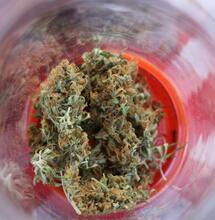Hydro Head-To-Head, PartI

If you want to try a hydroponic marijuana garden, here are a few tips to get started
If you want to try a hydroponic marijuana garden, here are a few tips to get started
As the summertime comes to an end, it is almost time to begin setting up the fall/winter indoor grow room, safe in the knowledge that our precious plants will no longer susceptible to Mother Nature punishing us with a heat wave. When you embark upon your winter grow and are eyeing up the options in your local grow shop, what will you choose? Good old-fashioned compost or a high-tech hydro system? Hydroponics can mean less maintenance, easier setups and a cleaner, compost-free growing environment - not to mention quicker harvests and increased yields! However, utilizing hydroponics also means constant monitoring of nutrients, toppling plants and leaky ceilings! There are plenty of hydroponic systems out on the market that employ many different hydroponic techniques: passive hydro, flood-and-drain, drip irrigation, deep water culture (DWC), nutrient film technique (NFT) and aeroponics. In Part I, we will take a look at the pros and cons of flood-and-drain, passive hydroponics and drip irrigation, plus how they compare to hand feeding. Part II will cover DWC, NFT and aeroponics.Passive Hydroponics: What Is It?
Unlike active hydro techniques, which employ a water or air pump to deliver nutrient solution, passive hydro techniques usually rely upon the capillary action of the chosen growing medium surrounding the roots - there is no pump involved. This is usually achieved by keeping the growing media in contact with a reservoir of nutrient solution, in its simplest form. Simply standing your pots in a tray and pouring nutrient solution into the tray is passive hydroponics. Some passive hydro systems involve ‘wicks' to transfer nutrient solution to the pot, while some of the more advanced systems, such as the AutoPot, use valves connected to a header tank to flood the tray that the pot sits in. Plants grown in a passive hydro setup will have near-constant access to water and food and, because most passive systems involve watering from underneath, the top part of the root zone remains highly oxygenated. Therefore, passive hydro can provide far superior results and still be incredibly simple to use and maintain. The more oxygen, water and nutrients that a plant can absorb, the bigger the yields they will produce.|
Nice flat canopy from the passive AutoPot system |
|
The low-level flood-and-drain table |
Flood-and-Drain: What Is It?
The principle of flood-and-drain is simple: plant sits on a table or in a bucket and nutrient solution is pumped in from a reservoir that then floods the table or bucket; when the pump turns off, the nutrient solution then drains away back into the reservoir. A timer is used to set the frequency of both the flood and drain periods. During the flood period, the roots of the plants are submerged, allowing them to take up all of the water and nutrients that they will need. All stale air is expelled from the root zone; then, as the solution drains away, fresh oxygen is pulled back into the root zone. As the plants grow larger, you increase the number of floods scheduled per day. The amount of nutrient solution used is easily measured and this allows experienced growers to tailor feeding schedules in order to receive the optimum yields from their plants. Flood-and-Drain Pros These systems are quite adjustable: At its most basic, flood-and-drain can be a simple way to keep your pots automatically watered; however, for the more experienced grower, it is the method that offers the most amount of choice, as you can amend the number of flood periods per day and how long each flood lasts. This way, you can tailor the system to your own growing environment - because everyone's grow room has a different humidity, temperature and airflow - and get the maximum yield from your plants. Root zone completely re-oxygenated several times per day: During the flood period, air is completely forced out of the root zone and fresh oxygen is pulled back in. The more oxygen that you can draw into the root zone, the healthier the plant. No build-up of nutrient salts: Any nutrients not used by the plants just drain back into the reservoir, instead of building up at the bottom of the pot. A build-up of nutrient salts will stunt growth, as it causes certain nutrients to be ‘locked out'. Flood-and-Drain Cons Complicated: The modular flood-and-drain systems can be a bit of a nightmare to set up and maintain. Although it is great that you can position modules where you like, setting up does involve tinkering with lots of pipework and washers. The best plan is to first place the pots where you want them, then lay your pipework around them. Misunderstood: This is not really the fault of the systems, but nobody really seems to use flood-and-drain tables in the United Kingdom. However, in the United States, every fucker out there seems to use them! They are incredibly simple to set up and manage, plus, you can still use pots and cocos with them. Come on, UK grow shops, catch up! Too tall for tents: Most of the flood-and-drain tables on the market sit on a stand with a large reservoir underneath them. Unfortunately, the larger tables need larger reservoirs to flood them and this takes up precious head room in a grow tent. Luckily, some manufacturers now produce lower-level tables with integrated reservoirs. Ask at your local grow shop for more info.|
Nice tree in a drip ring Flo-Gro system |
Drip Irrigation: What Is It?
There are many types of drip irrigation - pot drippers, drip ring systems, slab drippers - but they all work on the same principle. Your plants are started in a growing medium and a dripper is placed into, or suspended over, the medium. The dripper is attached to a dripper line, which is in turn attached to a pump. Your nutrient solution is contained within a reservoir and, at periods set on a timer, solution is pumped from the reservoir through the dripper line and delivered to each plant via the dripper. The nutrient solution works its way throughout the medium and over the roots of your plants, draining out through the growing medium and drawing oxygen into the root zone. Feeding small doses of water and nutrient at frequent periods throughout the day ensures that the growing medium will not become totally saturated, so there will always be plenty of oxygen present around the roots of the plant. As plants mature, the number of feed periods is increased in order to achieve optimum growth and yield. It is the preferred commercial method of crop cultivation for longer-term crops, such as tomatoes, peppers and cucumbers. Drip Irrigation Pros Totally flexible: Drip irrigation offers something for every grower, from the soil-lover who just wants to keep their pots automatically watered, to the hydro expert who is looking to measure the nutrient uptake of their crop on a daily basis and devise the perfect feeding schedule for their own growing environment. You can use it with any growing medium on any scale. Good mix of food, water and oxygen: When plants are fed little and often, the medium is never saturated and starved of oxygen. If done incorrectly, hand-watering plants once every few days can result in water-logging, where all of the oxygen is forced out of the root zone, and then the roots will take ages to take up the moisture from the medium. It is far less work than hand-feeding: You only have to mange one nutrient solution tank for all of your plants and top it up every couple of days, which is far easier than hand-watering. Drip Irrigation Cons Time consuming to set up: On a larger-scale operation, you will have at least one or two drippers per plant. Each one needs to be connected to the mainline from the pump with lots of fiddly fittings - fucking infuriating while you do it, but worth it, once it is done (provided that it does not leak!) Blockages: The dripper line has a small internal diameter and over the course of a full grow - eight to fourteen weeks, depending upon the chosen strain - there is the potential for these dripper lines to become blocked, particularly if you use concentrated mineral nutrients and stimulators (and if you want the biggest amount of bud possible, you will be!) Adding an anti-blocking agent to your reservoir, such as Keep It Clean or D-Block, will keep things flowing freely. Stay tuned for Part II, in which we discuss the pros and cons of deep water culture, nutrient film technique and aeroponic Cannabis growing systems.
S
Soft Secrets



